Tarocco Bolognese: Ottocento
This page is based on a description that was contributed by Alan Trangmar in 1996, which in turn relied heavily on research by Michael Dummett, as published in his book The Game of Tarot (Duckworth 1980). Some corrections have been made based on comments from Maurizio Barilli and further information and advice from members of the Accademia del Tarocchino Bolognese.
- Introduction
- Players
- Cards
- Playing Procedure
- Combinations
- Scoring
- Tactics
- Variants: Millone, Quattro Scartate, Signals, Scoring the Grande
- Substitute Pack
- Other Tarocco Bolognese WWW pages
- Online game
Introduction
Ottocento is a Tarot game for 4 players which comes from Bologna. Tarot games have been played in that city for over 500 years, and the game of Ottocento as currently played preserves distinct characteristics (both of the games and of the pack of cards) which go back at least to the 16th century. The special 62-card pack that is used and the game itself was sometimes referred to as Tarocchino (pronounced tarokino), the diminutive form of Tarocco referring to the reduction of the pack many centuries ago from 78 to 62 cards.
Ottocento is a point-trick game, with trumps. The cards have point values individually (as in other Tarot games) but these are dominated by the much greater value of the various card combinations. There is no bidding, but players can score by declaring card combinations held in their hands at the start of play, as well as for combinations taken in tricks.
Players
There are four players, two against two in fixed partnerships. Play is anticlockwise.
Cards
The pack is known as the Tarocco Bolognese - the version of the Tarot pack which has been used at Bologna since the 16th century. The cards are also commonly known as 'carte lunghi' (long cards) as they are physically longer than the cards of the Piacentine pattern that are generally used in that area for other card games such as Tressette. Tarocco Bolognese packs are produced and sold by the main Italian playing-card manufacturers Modiano and Dal Negro. They are somewhat similar to other Italian-suited Tarot packs, but omit the 2 to the 5 of each plain suit, and have other peculiarities found only at Bologna.
Players in North America can obtain Tarocco Bolognese cards from TaroBear's Lair.
Rank of Cards
There are 4 suits: 10 card each in swords (spade), batons (bastoni), coins (denari) and cups (coppe), plus 21 trumps, often referred to in Italian as numeri (numbers), plus one special card, the Matto, making a total of 62 cards. The rank of the cards from highest to lowest is:
- in swords and batons: King (Re), Queen (Regina), Knight (Cavallo), Jack (Fante), 10, 9, 8, 7, 6, Ace (Asso)
- in cups and coins: King, Queen, Knight, Jack, Ace, 6, 7, 8, 9, 10
- in trumps: Angel (Angelo), World (Mondo), Sun (Sole), Moon (Luna), 16, 15, 14, 13, 12, 11, 10, 9, 8, 7, 6, 5, the four Moors (Mori or Moretti), Bégato
The Angel, World, Bégato and Matto are also known as the tarocchi.
The Matto has no rank and is played according to a special rule, see Play.
All the numbered trumps also have pictures on them, for instance the 16 is the Star, the 15 is the Tower, and so on, but the numbers are the simplest way to identify them.
In play the four Moors are all equivalent (although they are not all visually identical - see below). If two or more Moors are played to a trick and no higher trump is played then the last Moor played wins.
(It is interesting to note in passing that this means there are 5 trumps ranked below the 5, and only 4 above the 16, so the numbers are not "correct". The most satisfying explanation of this is that the trump sequence was already established before the numbering was introduced and the numbers were chosen to retain the association of 13 with the death card).
Identification of Cards
At first sight, some of the cards in the pack may be hard to identify for those not familiar with them. In fact the pack is perfectly practical to play with (as 5 centuries of use have demonstrated), and after a little practice the designs are easy to recognise.
Numbered trumps: If there's a number on a card then it's a trump (whatever the picture may look like). In practice the most confusing one is the 8 of trumps (Justice) which shows a woman carrying some scales and a prominent sword, which might cause you to mistake it for a court card of the swords suit. You can tell it is in fact a trump from the fact that it has a figure 8 on it.
Unnumbered trumps: These are the most important cards in the pack: learn them and wake up if you see one!
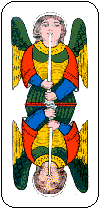
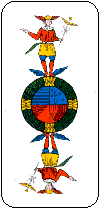
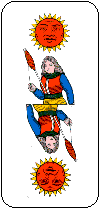
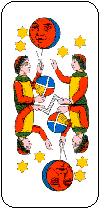
The top four trumps are the angel, the world, the sun and the moon. The angel blows a trumpet, the world is round, and the sun and the moon have fairly obvious pictures of these heavenly bodies.
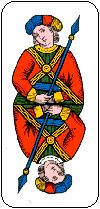
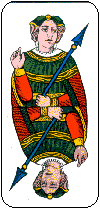

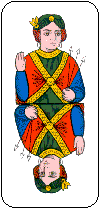
Immediately below the 5 of trumps come the four Moors. Two look the same, the other two look different, but all have equal rank during the play.
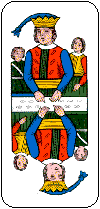
The Bégato is standing behind a table. He is the lowest trump, and is valuable as a counting card, as one of the tarocchi, and for his role in sequences.
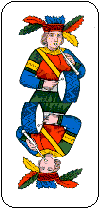
The Matto is not a trump. He beats nothing but a drum (see rules of play).
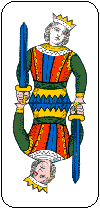
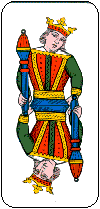
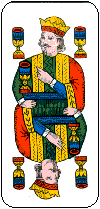
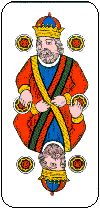
Here are the four Kings, of swords, batons, cups and coins. They all have crowns; two of them have beards, and the other two have their heads tilted to one side.

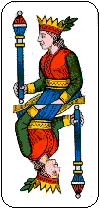
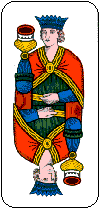
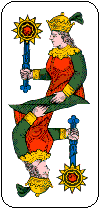
Here are the Queens of swords, batons, cups and coins. They have crowns and most of them look reasonably female
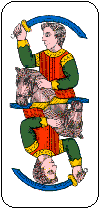
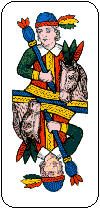


The Knights of swords, batons, cups and coins all ride horses.
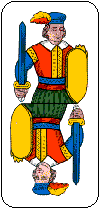

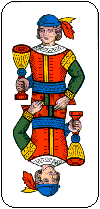
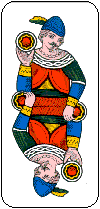
The Jacks of swords, batons, cups and coins are the ones with no crowns and no horses
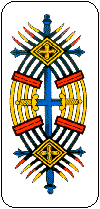
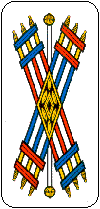
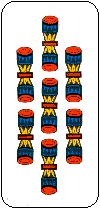
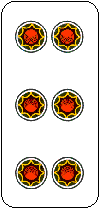
Here is a selection of pip cards (scartini). These can usually be identified by spotting the suit symbol and counting. Cups look rather like Christmas crackers. Swords on pip cards are curved while batons are straight; though most swords on court cards are straight. Swords and batons may have one or two symbols vertical or horizontal through the middle, separate from the other symbols. Illustrated here are the 10 of swords, 7 of batons, 7 of cups and 6 of coins. The 10 of swords has eight curved swords, a long straight vertical sword and a short straight horizontal sword.

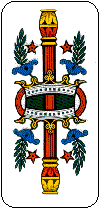
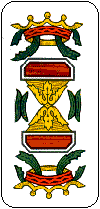

 Here are the aces of swords, batons, cups and coins. Note that the monochrome card with the blank circle is the ace of coins. The blank circle originally held the tax stamp but this is no longer required. The funny looking card with two circles connected by a bar is the ace of swords. It is in fact a double ended version of a rather strange sword ace with a hook-shaped blade.
Here are the aces of swords, batons, cups and coins. Note that the monochrome card with the blank circle is the ace of coins. The blank circle originally held the tax stamp but this is no longer required. The funny looking card with two circles connected by a bar is the ace of swords. It is in fact a double ended version of a rather strange sword ace with a hook-shaped blade.
Card Points:
The basic values are as follows:
| Tarocchi (Angel, World, Bégato, Matto) | 5 each |
| Kings | 5 each |
| Queens | 4 each |
| Knights | 3 each |
| Jacks | 2 each |
| All other cards | 1 each |
Cards are counted in pairs, deducting one point from the value of each pair. (Because each trick contains 4 cards the number of cards captured by each side must always be even.) Of course this is the same as deducting half a point from each individual card value, so for instance a King is worth as much as 9 other cards (4.5 to 0.5).
The total number of points in the pack is 87. In addition there are 6 points for the last trick.
Playing Procedure
The game is played anticlockwise. Partnerships remain fixed until a rubber is completed (800, hence Ottocento). The deal for the first hand of each rubber is decided randomly, after that the deal passes to the right after each hand.
The sequence of events on each deal is:
Deal
The dealer shuffles and gives the cards to the player to the left to cut. The cards are then dealt out in packets of five cards, starting with the player on dealer's right. This means that at the end of the third round of the deal each player other than the dealer has 15 cards, but the dealer has an extra two cards in addition to final the packet of 5. Everyone picks up their cards and the dealer discards two cards face down to reduce his hand from 17 to the same number of cards (15) as everyone else. These discarded cards count for dealer's team at the end of the hand as if they had been won in tricks (however they are lost if dealer's side loses every trick). Dealer is not allowed to discard 5-point cards (Tarocchi and Kings), but may discard other trumps (this differs from the custom in many other Tarot games).
Note. The dealer has the option to score for declarations using just the first 15 cards if this gives the dealer's team enough points to win the game. For this reason, if the dealer's team's score is close to 800, the dealer should not pick up all 17 cards at once but leave the last two face down on the table while studying the first 15. If the first 15 cards do not contain enough declarations to reach 800, the dealer then picks up the last two cards and discards in the normal way.
Declarations
During the first trick, players may declare combinations of cards which have special scores: see Combinations. Note that the score is doubled only if three or more combinations of the same type are declared by the same player - it is not enough for the partnership to declare three between them.
Each player makes any declarations they wish to immediately before playing their card to the first trick. Combinations are declared by placing all the relevant cards face up on the table. After declaring, the player then plays to the first trick and picks up the cards displayed (if any); then the next player declares and plays, and so on.
Declarations are not compulsory. Players are allowed to declare only some but not all of the combinations they hold, and may even make a declaration which is less than the maximum possible - for instance it is legal to declare a sequence of 4 swords when 5 could be declared or three Queens when holding four. Of course points are only scored for what is actually declared.
The dealer cannot include the cards that were discarded in declarations.
The Play
Any card may be led. Other players must follow suit if they can. If they have no cards of the suit led then they must play a trump. The trick is won by the highest card of the suit led, unless it contains a trump in which case the highest trump wins. If the highest trumps are two or more Moors, the last Moor that was played wins the trick. The player to dealer's right leads to the first trick. Thereafter the winner of each trick leads to the next.
The Matto is an exception to the above: it may be played to any trick regardless of whether or not the player has any cards in the suit led. When it is played, it is always retained by the side that played it. If the other side win the trick then the side that played it give them a worthless card in exchange. This can be any card they have previously taken in tricks, but if they have not yet taken any card of sufficient worthlessness they are allowed to wait until they do. In this case the Matto can be left face up as a reminder. Remember that many cards have some potential value, either in themselves or in combinations: usually a pip card from a suit is chosen to give in exchange, or a low numbered trump can be given once the trump sequence is known to be stopped (see Sequences). At the end of the hand, if no earlier, they must give a card in exchange; if they have taken no tricks at all then the Matto would be lost (this hardly ever happens).
If the Matto is led then the second player may play any card and this determines the suit of the trick.
Signals
There are three signals which a player can make to her partner at the same time as leading to a trick. Their meanings, in principle, are as follows.
- volo: toss the card in the air: "This is my last card in this suit" (or last trump if leading a trump).
- busso: strike the table with the fist. This is a signal of strength, whose meaning varies according to the context - see tactics. In principle it shows strong trumps, requests partner to play a high card to the trick, and requests partner to return a trump or the same suit when on lead.
- striscio: scrape the card along the table: "I have at least one more card in the suit that I am leading" (or long trumps without the highest ones if leading a trump).
A signal can only be given when leading a suit of which the King has already been played in a previous trick, or when leading a trump irrespective of what has previously been played. Only one signal can be made in any one trick.
It is strictly forbidden to use signals other than these (though in the 19th century there were versions of the game with many more signals). It is also considered highly unethical to use signals with a meaning substantially different from the generally accepted meaning.
See Tactics for further advice on on how these signals are used.
Combinations: Criccone and Sequences
Combinations can be scored in a player's hand at the start (see Declarations) and are also scored at the end of the hand in cards captured in tricks. In either case the scoring combinations are the same.
Criccone
These are combinations of three or four cards of a kind. Historically, a single combination of this sort was known as a cricca, and three or more different cricche together were known as a criccone. However the word cricca for a single combination has now fallen into disuse.
The combinations of the criccone score as follows:
| All 4 cards | Any 3 cards | |
|---|---|---|
| Tarocchi (Angel, World, Bégato, Matto) | 36 points | 18 points |
| Kings | 34 points | 17 points |
| Queens | 28 points | 14 points |
| Knights | 26 points | 13 points |
| Jacks | 24 points | 12 points |
If three or more of these combinations are collected by the same team in cards that they took in play (for instance 3 tarocchi, 4 kings and 3 jacks) then the player or team has a criccone and the total score for the combinations is doubled. The same also applies in the unusual case where a single player declares three or more of these combinations at the start of play: the player has a criccone in hand and the score for the combinations is doubled.
Sequences
These are combinations of 3 or more cards and score according to the number of cards in the sequence:
| 3 cards (minimum) | 10 points |
| each additional card | 5 points |
If three or more different sequences are collected by the same team in cards that they took in play (for instance Swords, Aces and Moors) then the total scores for these sequences are doubled. Also, if a single player declares three or more sequences in hand at the start of play, the score for them is doubled.
All sequences have a minimum condition to establish the sequence; once established, additional cards may be added under less restrictive conditions.
The Matto and Bégato are wild cards (contatori) which can be used in place of some of the cards which would normally be required in sequences. If not needed to establish the sequence they can always be added to the length (and hence the score) of any sequence, even if all possible "real" cards are already present. Each wild card held can be used in every sequence.
- Trump sequence (grande):
- The Angel, which must be real (that is, it cannot be substituted by a wild card), and at least two of the next three trumps (World, Sun, Moon), at least one of which must be real. Once established, further trumps can be added in sequence from the 16 on down until there is a missing trump. Wild cards can be used in place of numbered trumps, and the sequence can continue, but:
- each wild card can be used only once in each sequence. In particular, if it has been used to replace the World, Sun or Moon it cannot be used again to replace a numbered trump.
- two adjacent wild cards end the sequence; wild cards cannot be used consecutively to fill two gaps in the middle of the sequence.
- With enough trumps, the trump sequence can even include Moors (this is in addition to the Moors potentially scoring as a sequence in their own right). A trump sequence that includes Moors is known as a "grande fino ai calzettini" (trump sequence down to the socks).
- Suit sequence:
- The King, which must be real, and at least two of the next three cards (Queen, Knight and Jack), at least one of which must be real. Once established, the Ace can be added.
- Moors sequence:
- At least three Moors, at least two of which must be real.
- Aces sequence:
- At least three Aces, at least two of which must be real.
Examples:
- Angel, World, Moon, 16: trump sequence of 4, worth 15 points
- Angel, Matto (for the World or Sun), Moon, 16, 15, Bégato (for the 14), 13, 12: trump sequence of 8, worth 35 points. Note it is not necessary to replace both the World and the Sun with wild cards.
- Angel, World, Sun, Moon, 16, Matto, Bégato, 13: trump sequence of 7, worth 30 points. Note this is not a sequence of 8: both the 15 and the 14 are missing, the gap of two stops the sequence, and the 13 cannot be added.
- Angel, World, Bégato, Matto, 15, 14: trump sequence of 4, worth 15 points. The contatori can be counted, but they cannot be used to connect the 15 to the sequence, because one would have to represent the Sun or Moon and the other the 16, making them adjacent.
- Angel, Matto, Sun, Bégato, 15, 14: trump sequence of 6, worth 25 points. This differs from the above only in having the Sun instead of the World. But now we can use the Matto to represent the World, separating the wild cards and enabling the 15 and 14 to be included in the sequence.
- King, Matto, Bégato, Ace: Not a sequence (at least one of the queen, knight, jack must be real)
- King, Knight, Jack: suit sequence of 3, worth 10 points
- King, Queen, Bégato (for Knight or Jack), Ace: suit sequence of 4, worth 15 points
- King, Queen, Knight, Jack, Ace, Matto: suit sequence of 6, worth 25 points.
- Two Moors, Bégato: sequence of 3, worth 10. Note that at the end of the play if one team has this sequence, the other team will also score a sequence of Moors: Two Moors and the Matto.
- Four Aces, Bégato, Matto: sequence of 6, worth 25 points
Scavezzo della grande
When scoring at the end of the play, this is the numbered trump that "breaks" the grande, that is the numbered trump held by the opponents of the team that has the Angel that marks the end of the trump sequence. This card is the basis of a shortcut method of scoring the grande which is used by all regular players. To novices it looks completely mysterious but for a long grande it is much quicker than pulling out all the cards of the grande and counting them. For this method it is only necessary to look at the trumps and contatori taken by the opponents of the team that has the Angel. It works like this.
- If the opponents of the Angel have the World, Sun and Moon, or if they have two of these three cards with both contatori, there is no grande.
- Otherwise, identify the scavezzo (breaking card) - the highest numbered trump held by the opponents of the Angel that is not in the grande. Count how many contatori and trumps higher than the scavezzo the opponents of the Angel have, add this to the number of the scavezzo itself, subtract the result from 21 and multiply by 5. This is the value of the grande.
- If there is no scavezzo - so that the team with the Angel have a grande fino ai calzettini (down to the socks) - then the scavezzo number is zero. Count all the trumps and contatori held by the opponents of the Angel, subtract that number from 21 and multiply by 5.
Examples:
- In example 1 above the scavezzo is the 15, and the opponents of the Angel have both contatori and the Sun. 15+3=18. 21-18=3. The value of the grande is 3×5=15.
- In example 2 the scavezzo is the 11, and the opponents of the Angel have the World, Sun and 14 of trumps. 11+3=14. 21-14=7. The value of the grande is 7×5=35.
- In example 3 the scavezzo is the 15 and the opponents have no trumps or contatori to count. 21-15=6. The value of the grande is 6×5=30.
- If the opponents of the Angel have nothing relevant except the 7 of trumps, the Matto and one Moor the scavezzo is 0, 21-3=18 and the value of the grande is 18×5=90. This is a case in which the scavezzo method is clearly quicker than counting all the cards in the grande. The team with the grande will also score 15 for their sequence of Moors in this case.
Scoring Procedure
Although the scoring in the present-day game may seem fairly complex (each hand ends by laying out most of one side's cards on the table), it is in fact a simplification of an earlier game which had another level of scoring on top of the one which is used today.
As already stated, combinations announced during the first trick are scored at that time.
All other scoring is at the end of the hand: card points for cards captured, points for the last trick, and points for combinations of cards captured. The usual way of doing this is as follows.
- Take one side's pile of cards captured (including dealer's discard if this side were dealer) and lay them out on the table so as to show all the significant cards of each suit (Kings, Queens, Knights, Jacks, Aces, in a matrix of suit by rank), and all the significant trumps, and Moors. (It is best to choose the smaller pile of the two!).
- Score for the criccone. Do this first for the side whose cards are on the table and then for the other side (spotting the gaps: for instance if only one King is visible then the other side must have three Kings). Remember to double the score for a side that has three or more of these combinations.
- Give 6 points to the side that won the last trick. This is traditionally added to the criccone score (but never doubled).
- Score for sequences (sequenze). Do this first for the side whose cards are on the table and then for the other side (spotting the gaps). Since there are seven possible sequences, it nearly always happens that one side, and not infrequently both sides have three or more sequences and therefore double their sequence score. The way this is normally scored is by counting the total number of cards in all the sequences, subtract one for each sequence, and then multiplying the result by 10. If the side has fewer than three sequences the result is halved.
- Count the cards, putting one 1-point card on top of each 2- 3- 4- or 5- point card and scoring the value (see card points above), then counting the remaining 1-point cards in pairs, scoring 1 for each pair. The other side's card points are then worked out by deducting from 87.
The rubber is won by the first side to reach 800. If both sides reach 800 on the same deal then the side that goes further beyond 800 wins.
It is possible for a team to win the game without playing any cards if either the dealer or the player to dealer's right can score enough points from declarations to take the team's score to 800 or more. The dealer has the first opportunity to do this but can only use the first 15 cards dealt. If the dealer is unable to reach 800 with declarations, the dealer does not declare but instead picks up the last two cards and discards, and the player to dealer's right has the opportunity to end the game if able to score enough for declarations. If the player to dealer's right is also unable to end the game, she makes any declarations she wishes to and leads to the first trick. The other three players declare if they wish to as they play their first cards, the dealer declaring last in the usual way. Declarations by players other than the player to dealer's right made during the first trick do not end the game even if they take the team's score to 800 or more. Once the first player has led to the first trick the whole hand must be played out, and the winners will be the team with more points at the end of play.
Tactics
This section was originally written by Alan Trangmar. It has been revised and rewritten in the light of advice from Gianfranco Laghi's book I Giocchi dei Tarocchi Bolognesi, and the members of the Academia del Tarocchino Bolognese.
Observations on the cards and their values
The first thing to notice is that the scoring is dominated by the scores for combinations, and the biggest swing on most hands is on sequences: if one side fails to collect as many as three sequences in their tricks they tend lose by a large margin. The key cards for forming sequences are the Angel and the four Kings, which are necessary to head the grande and the suit sequences respectively, and the two contatori, the Matto and Bégato, which can be used in all sequences. The Angel and the Matto cannot be captured in play, but the Bégato and the Kings can. Therefore one of the most important objectives of the play is to collect as many as possible of the five key cards: the Bégato and the Kings.
The next most valuable cards are the World and the Queens, Knights and Jacks of the suits, which score both in sequences and in the criccone, and the Aces, which score in two kinds of sequence. The Queens, Knights, Jacks and Aces are not very different from each other in value - their relative importance depends mainly on how they fit with the other cards collected by the team. The Sun, Moon and Moors are generally of less value since they normally contribute to only one sequence.
The Sun and Moon are known as rossi (red cards) and the World, Sun and Moon are collectively known as pezzi - that is 'pieces' (of the grande).
Choosing the discard
The dealer is known in Italian as il scartatore (the discarder) and has to begin by discarding two cards. Usually the dealer should try to discard an entire suit to create a void, and aim to capture the King and other valuable cards of that suit by trumping them. Another possibility, if holding three or four Kings, is to bare one or two of the Kings by discarding the other cards of their suits, so as to capture the other valuable cards of this suit by trumping.
If it is not possible to create a void, the dealer should aim to discard cards that will be useful in combinations, especially Knights, Jacks and Aces. Also it may be worth creating a singleton so as to be able to trump the second round of a suit.
Declaring combinations in the first trick
A beginner's instinct is usually to declare any and all combinations that they hold, so as to score as many points as possible, but experienced players often suppress declarations, especially sets of Queens, Knights, Jacks or Aces.
In general, it is right to declare the grande, a set of tarocchi and any combinations that involve Kings, as it is useful for partner to know the locations of these cards. Also it is usual to declare Moors if held, because it does no harm and scores a few points. If you are lucky enough to have three or more sequences or three or more sets from the criccone it is worth declaring them to obtain the double score.
The problem with declaring a set of court cards below the King or a set of Aces is that although it scores you a few points, it also lets everyone know that you are not void in those suits. This information can be useful to the opponents - if you have not yet played the card you declared they know you will have to follow suit and this may help them to save the King or to trump with the Bégato secure in the knowledge that you will not overtrump.
Many players use a declaration of a set of three Aces, Jacks, Knights or Queens as a strong suggestion to partner to lead the fourth suit. The player who made the declaration is probably void or at least short in that suit and wishes to trump it. This agreement is particularly useful for a declaration by a player other than the dealer, as the player's partner would not be expecting them to have a void in this case.
Of course all players should pay careful attention to who declares what, to find out and remember as much as possible about the positions of the key cards. Negative inferences may also be drawn from cards that are not declared - for example if three players have declared sequences without including the Bégato it is likely that the fourth player has it. It is conceivable that one of the players who declared a sequence might be keeping the Bégato concealed, though such concealment carries the risk the player's partner will be unaware of the need to help save the Bégato.
Planning the play
In his book, GF Laghi identifies two styles of play - the attacking game and the passive game. Your initial hand may indicate what type of game you would prefer, but as in any partnership game it is important to base your decisions not only on your own cards, but on what you can discover of your partner's hand and preferences and your opponents' strengths and weaknesses. Your plan may need to be modified as the game develops.
An attacking game is one in which you try to impose the course of the play on the other players. There are a few types of hand that lend themselves to an attacking game.
- With a long suit (4 or more cards) and an average or greater number of trumps (say 6 or more), it is best to lead the long suit, aiming to shorten the trumps of the other players and thereby win the last few tricks.
- With a short suit (1 card) and short trumps, lead the short suit so as to use your trumps productively when partner returns it, and after running out of trumps hope to save your valuable cards on partner's trump tricks.
- With a hand that is very rich in valuable suit cards, play trumps so as to eliminate the opponents' trumps and increase the trick-taking power of your suit cards.
If your hand is not suitable to initiate an attacking game, then you prepare yourself to support your partner's plan if your partner shows a desire to be in charge of the game, or if your partner is the dealer.
If neither partner has a suitable hand for attack, you play a passive game, which will be devoted to trying to frustrate the opponents' aims, spoiling their combinations when possible by capturing valuable cards. You do not lead trumps, and when possible you avoid leading a new suit for the first time. You get home your valuable cards when the opportunity arises, and lead back suits that have been led before.
There are of course also deals which are evenly balanced, where neither team is in a position to mount a sustained attack, and the players simply try to make the best use of opportunities as they arise.
Playing suits
The first thing to realise is that in the initial stages of the play it is almost always wrong to lead a suit in which you hold the King. It is better to wait for someone else to the lead this suit. There are a few exceptions.
- A singleton King can be led, inviting partner to return the suit so that the player can trump it.
- The King can be led from King-Queen, if the player leading the King is confident that it will not be trumped.
- A member of the dealer's team may begin a long suit attack by leading the King of the suit.
The only situation in which a low card is led away from a King is in the later stages of the game, when the player is certain that an opponent will trump the trick.
When another player leads a suit in which you hold the King it is usually best to play the King on the first round. A possible exception is when you are playing fourth, the other three players to the trick have all played scartini (pip-cards), and you hold the King with just one other card of the suit. In this case it can be worth holding back the King aiming to capture some court cards on the second round of the suit to build a sequence.
Often the first lead in a suit will be a pip card led by a player who does not have the King (the partner of the dealer may do better to begin with a court card or an Ace rather than a pip card if there is a good chance that dealer has discarded the suit). The low card from a suit of Q-x is often a good lead, since the holder of the King is quite likely to play it and then the Queen may then win the second round of the suit, hopefully picking up some useful cards.
It is important for the dealer's partner to discover what suit the dealer has discarded. Sometimes this is immediately clear from the dealer's declarations. If the dealer's partner does not have the King of the discarded suit, they need to make sure the dealer has the chance to trump it as often as needed to capture the valuable cards in it, hopefully including the King. When it turns out that unfortunately the dealer has discarded a suit in which partner holds King-Queen or King-Knight it is usually not in partner's interest to lead this suit, and the dealer's team will wait for it to be led by the opponents.
Usually you avoid leading from a suit headed by two valuable cards. When you do make such a lead, you begin with one of the valuable cards unless you know that an opponent holds the King. The cases when leading a suit headed by two valuable cards may be desirable are:
- when the suit is doubleton - especially Queen-Knight in which case you hope to win the second round;
- when attacking from a long suit headed by two valuable cards;
- when the leader is the dealer's partner.
Since no signal in a suit is allowed before the King has been played, an opening lead of a small suit card is ambiguous. It will only be clear from the declarations or the subsequent play what kind of hand the player has.
Leading trumps
There are two main motives for leading trumps early in the game.
- The player has long trumps (7 or more) and hopes to draw the enemy trumps, possibly capturing the Bégato.
- The player has a hand rich in valuable cards and wants to encourage trumps to be played so as to save these cards later, for example by exhausting the dealer's trumps before the dealer has a chance to trump the suit they have discarded.
When leading trumps it is usually best to begin with a small numbered trump. These cases can be distinguished to some extent by the signal that the player makes or does not make along with the lead.
- Leading a trump with a busso in principle indicates that the leader holds the highest outstanding trump - initially the Angel. In some contexts some players also use this to signal very strong trumps headed by the second highest (initially the World), but if partner's Bégato is likely to be in danger a busso should guarantee the highest trump, so that partner can rely on it if necessary to save the Bégato. Partner is invited to play a medium-high trump and to return a trump when next obtaining the lead if holding a suitable hand.
- Leading a trump with a striscio indicates that the leader has long trumps (at least 7) but holds neither of the top two. Again partner is invited to play a medium-high trump and to return trumps at the next opportunity if willing to cooperate in a trump-drawing strategy.
- Leading a trump without making any signal indicates that the leader's trumps are not particularly long or strong, but the player is keen for trumps to be played. The leader has no void or short suit that they wish to trump and a hand rich in valuable cards in the suits. Partner should usually not play a high trump, only high enough to beat the second player's card if necessary, to prevent the fourth player from easily saving the Bégato or a Moor.
The strategy of leading trumps has some potential disadvantages that should be weighed against the benefits. There is the risk of putting partner's Bégato in danger, and the probability of conceding several useful trumps to the opponents.
Typically a low numbered trump is led and the second player will often contribute a Moor because the fourth player is in a good position to beat whatever the leader's partner plays. Lacking a Moor the second player will normally beat the led card as cheaply as possible. The third player will not want to waste the Angel on a trick containing nothing better than a Moor, and will be reluctant to play a pezzo (high unnumbered trump) for fear of losing it. If partner has led a trump with a busso or striscio the third player will usually play a number around 13-15. By beating (for example) the 14 with the 15 the fourth player may collect a Moor and couple of very useful cards to build a grande or to break the grande at a high level depending on which team has the Angel.
Because of the risks, a player should generally not insist unilaterally on a trump leading strategy, but be guided by partner's response. If partner returns a suit rather than a trump on obtaining the lead, it may mean that they have short trumps and want to use them to trump voids or short suits, or it may be a sign of the Bégato in danger.
Returning a lead
When you lead a suit that has been led before, usually the King has been played on the first round so there is the opportunity to make a signal. A striscio or volo indicates whether or not the leader has further cards of that suit, and may help partner to judge the distribution of the suit. It can also help the opponents of course, so it is wise to signal only when having a particular plan in mind. When the opponents have the balance of the cards and you are playing a passive game it is better to give out as little information as possible.
A busso when leading a suit indicates strong trumps, and suggests that partner should either return a trump when they next obtain the lead, or return the same suit so as to force the opponents to trump.
When leading a trump in response to partner's invitation, you signal the quality of your own trump holding. A busso shows at least one high unnumbered trump, a striscio shows reasonably long trumps without any high ones, and a volo shows that you are leading your last remaining trump in support of your partner's plan, since you have no better use for it. Returning a trump without a signal shows a trump holding that is neither long not strong, and a willingness to go along with the plan because you have no short suits (singletons or voids) where you would prefer to use your trumps.
Leading a suit when partner had requested a trump lead suggests that you do not want to play trumps because you have a void or short suit that you want to trump, and perhaps also because your Bégato is in danger.
Trump ripping and entries
Sometimes an effective method to exhaust the opponents' trumps is by repeatedly leading a long suit that they both have to trump. Ripping the opponents' trumps in this way is known in Italian as accorciamento (shortening). This is not always an unpleasant experience for the players whose trumps are ripped, because in the process they may capture several useful cards. The ripping strategy also has the drawback that the player leading the long suit loses the lead each time it is led, so the player also needs sufficient entries (such as Kings or high trumps) to regain the initiative in order to lead the long suit again.
The most favourable configuration for ripping is when one partner has a long suit and long trumps while the other is short in that suit with short but good trumps. When the long suit is led the opponents have to beat the short partner's trumps if they want to obtain the lead, and the player with short trumps, after using them all to good effect, has the opportunity to save valuable cards on partner's remaining trump tricks.
Another favourable situation is when you hold a suit in common with your left-hand opponent, the other two players having run out. If you lead this suit your right-hand opponent must trump and partner can overtrump. It is important to keep count of the cards in the suit to know when your left-hand opponent also becomes void. The signals striscio and volo can be used to help your partner to estimate whether the fourth player will also be trumping.
Saving the Bégato
The player holding the Bégato will be thinking about the safest time to play it. With long trumps (say 7 or more) there is no great urgency, a chance will probably appear. With a short trump holding something may need to be done quickly. The safest way is to play it under partner's Angel - if partner has it. If the owner of the Bégato has a void or singleton it may be possible to use it to trump a side suit. This is satisfying (it may capture a King) but not entirely safe, especially if the dealer has yet to play to the trick (dealer often creates a void with the discard). In a desperate situation, the best chance may be to play the Bégato to a trump trick in which partner is playing last, or even just to lead the Bégato and hope that partner can win if it is clear that there is no other chance to save it.
In this, as in all the play, players should remember the information they gained from the declarations on the first trick. If the partner is known to hold the Angel then it is safe to lead the Bégato. If the third player to a trick is void of the suit led and the fourth player has declared a card in the suit which they haven't yet played, then it is safe for the third player to trump with the Bégato.
The unusual lead of a King may suggest that it is a singleton (so unlikely to be trumped), and that the player intends to try to save the Bégato by trumping the second round of the suit.
The Endgame
Players who have run out of trumps can use the cards they discard to indicate to their partner the relative strength of their suits. Discarding a suit card shows weakness in that suit, and if a player discards cards from two or three suits, partner can infer that their strength if any lies in the remaining suit(s).
Towards the end of the game, especially when partner has run out of trumps, the meanings of the busso and striscio signals when leading trumps are modified.
- Busso means 'I have strong trumps, but not very many. Save your valuable cards by playing them now before my trumps run out'.
- Striscio means 'I have long trumps, but not necessarily the top ones. Hold on to your winning cards in the suits and discard your weak suits, so that after I have eliminated all the trumps we can take the remaining suit tricks.'
Occasionally in the last few tricks, if you have an accurate idea of who holds which cards, it can be profitable to endplay an opponent, forcing them to take the lead in order to capture a valuable card from them.
Use of the Matto
The Matto can be a difficult card to use well. It should normally be played on a trick that is being won by partner or an opponent. It is nearly always a mistake to lead the Matto, since it gives the next player a free choice of play and often allows them to save a valuable card that would otherwise be lost.
The easiest way to use it is to effectively lengthen your trumps or one of your suits by playing it to a trick in that suit or trumps in place of the losing card that you would otherwise have to play.
Occasionally it can be used in the endgame to avoid taking the lead from an opponent and thereby force them to lead into a holding with which you can capture a valuable card. For example if your opponent has to lead from World, 13, 12 and you hold Angel, Sun, Matto (the other players having no trumps) you will play the Matto on the lead of the 13 or 12 in order to capture the World.
Special care is needed when holding the Matto in a strong hand. You will need to plan when to play the Matto, usually playing it quite early, and at all costs avoiding the situation where you are left on lead with nothing but winners and the Matto, and thus are forced at some point to lead the Matto and watch your opponents save a couple of key cards.
Variants
Millone
When a series of games of Ottocento is played, sometimes the last game of the session is played as Millone (1000), the only difference being that the target score to win this game is 1000 points rather than 800.
Millone or Mille is also the name of a two-player game with Tarocco Bolognese cards in which 20 cards are dealt to each player, each discards 10, then 10 more cards each are dealt, plus two more to the dealer and the dealer discards another two cards. As usual five-point cards cannot be discarded and all discarded cards count for the player who discarded them at the end of the play. The target score to win the game is 1000 points over as many deals as it takes.
Quattro Scartate
This is the same game as Ottocento, but instead of playing to a target score of 800, four deals are played and the final scores determine the margin of victory for the team with more points. Some groups prefer this format to Ottocento because it gives each player in turn the advantage of being the scartatore, unlike a game of Ottocento which is often completed in three or even just two deals.
Use of Signals
The signals explained in the main description above are those allowed by the Accademia del Tarocchino Bolognese. However, there are places where more signals are allowed and at least one place where the game is played with no signals at all.
In general if more signals that are allowed the play can be planned more accurately, which favours the team with the stronger cards. With too many signals all uncertainty is removed: the play becomes uninteresting and the team with weaker cards has no chance. Without signals the players are more in the dark, and must rely on probability, guesswork and instinct.
In the main description above, one controversial rule is the ban on signalling in a suit before the King has been played. In the past many circles allowed such signals, making it easier for a player to indicate their preferred strategy at the start of the game.
Another controversy centres around whether players are allowed to bluff, for example giving a 'fake' volo signal holding more than one card of the suit led, and even attaching an extra meaning to this, such as using a fake trump volo to show short trumps with the Angel. A few pairs use this while others consider it unethical.
When playing for the first time in an unfamiliar group who may have different conventions, it is advisable to agree the house rules on what signals will be allowed before beginning the game.
Scoring the Grande
In the past there has been controversy over the interpretation of the rule that contatori cannot be used as substitutes for two consecutive trumps in the grande. The version in the main description above is widely accepted as standard: it corresponds to the original rules of the game according to the accounts we have and is endorsed by the Accademia. In his 1983 book, Gianfranco Laghi notes the following alternative interpretations, which may still be current in some places.
- Some say that if the Sun and the Moon are missing, the 16 cannot be added to the grande.
- Some say that if the Moon and 16 are missing, the 15 cannot be added to the grande.
The standard interpretation is that the Moon is not necessary for the grande, so in these two cases the grande is not broken provided that sufficient contatori are held.
Substitute Pack
If you cannot find a Bolognese Tarocchi pack then it is theoretically possible to play the game with another Tarot pack, for instance a cut-down Tarot de Marseille or Tarocco Piemontese, but a number of substitutions would have to be made in trumps:
- XX used for the Angel (highest trump)
- XXI for the World (note that the XX beats the XXI)
- XIX for the Sun
- XVIII for the Moon
- XVII for the 16 (!) (Star)
- ...
- VI for the 5
- V, IIII, III, II for the 4 Moors (replaced by popes and emperors)
- I for the Bégato
This is only recommended as a last resort since the individuality of the Bolognese cards is one of the attractions of the game.
Other Tarocco Bolognese WWW pages
Here is the web site of the Accademia del Tarocchino Bolognese - an institute devoted to the promotion and development of the game.
Maurizio Barilli's Tarocco Bolognese web site includes rules for Ottocento and for several closely related games, including versions for 2 or 3 players.
The card game encylopedia at tretre.it includes rules for Tarocchino Bolognese. At this site there is also the Biblioteca del tre, which has reproductions of several early books about Tarocchino, and a copy of the earliest known rules for Tarocchino, from a manuscript dating originally from the late 16th or early 17th century, and transcribed by Pedini in 1746.
Online Game
You can play Ottocento, Quattro Scartate and Millone online against live opponents on Joe Elleson's Online Card Games site. The user interface is available in Italian or English. It is free to use but a login is required.